|
HOME STUDIO Cool DIY Plan: How To Air Condition Your Voice Over Home Studio Recording Booth  By Greg Thomas By Greg ThomasVoice Actor WARNING:
The following contains graphic pictures of exposed duct work that may
not be suitable for those who are sensitive to interior design or
practice feng shui. This project also comes with the potential for a low
spousal approval rating. Check with your significant other before
proceeding. Scorching temperatures, often over 100°F, might again hit much of the U.S. this summer. These unusually hot weather
conditions have caught most of the country by surprise.
For those of us in Texas, though, it's business as usual. Summertime
temperatures above the century mark, sometimes for a week or more, are
common all over the state from June to August.
If you've never experienced a Texas summer, it's hard to imagine what
it's like living with that kind of heat on a daily basis. A LITTLE SWEAT BOX You may have heard (or know from
experience) that an isolation booth can quickly turn into a little sweat
box, especially in the summer. The computer fan and dryer hose that
typically come with a booth just can't keep up with torrid summertime
heat. I've heard both male and female voice actors tell of recording in
only their underwear because their booth was so hot. Even if the booth starts out at a moderate temperature, after you're
in there for 20 or 30 minutes, your body heat alone will cause the
temperature to rise significantly. And if all you're doing is pulling
room-temperature air into a heavily insulated booth in the summertime,
it's a losing battle. Your body heat can't get out fast enough, and the
isolation booth turns into a padded dry sauna. COOL IDEA ... WHAT IF? One hot summer day, I was sitting at the desk outside my VocalBooth®* while
the air conditioner was blowing cold air onto my balding head. 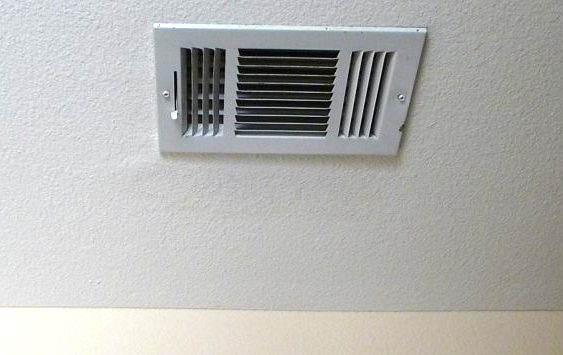 The cold
air must have kicked my brain cells into action, because it got me to
thinking ... The cold
air must have kicked my brain cells into action, because it got me to
thinking ... What if I could find a way to get some of that 60°F air out of the vent in the ceiling ... and route it to the ventilation duct in my booth? 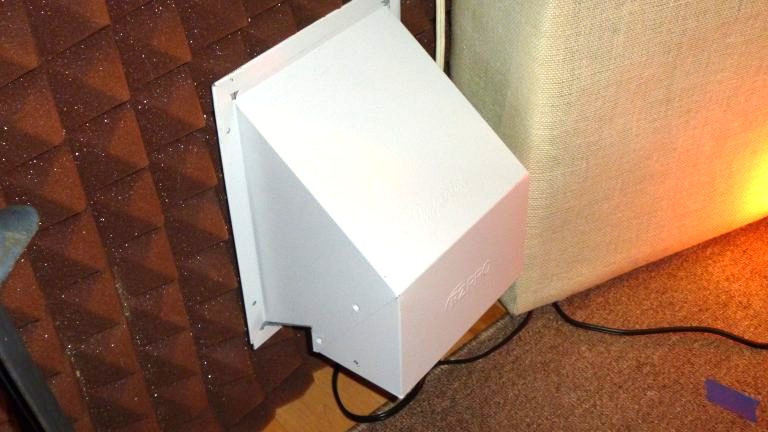 Would that cool off my booth? Would it bring an end to soaked arm
pits, sweat-stained scripts, and repeatedly opening the door of the
booth to try to cool off? There was only one way to find out.
Build something (I didn't know what just yet,) and see if it worked. LEFTOVERS ARE A WONDERFUL THING A few years earlier, in what turned out to be a futile attempt to cool
the booth by getting more air into it, I enlarged the ventilation hole
from 4 inches to 6 inches, and pushed room air into the booth through a
Panasonic FV-15VQ5 WhisperCeiling 150 CFM Exhaust Bath Fan that I'd
bought to replace the ineffective computer fan. 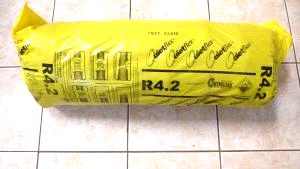 The booth was connected to the fan with Quietflex duct.
(Be careful opening this stuff. It tends to come out of the wrapper like one of those spring-loaded snakes in a can.) The booth was connected to the fan with Quietflex duct.
(Be careful opening this stuff. It tends to come out of the wrapper like one of those spring-loaded snakes in a can.) Since I had plenty of Quietflex left over, I just needed a way to tap
into the ceiling vent and get the cold air to the fan. After a
long-distance call to a good buddy who used to run his own air
conditioning company, I knew I had a plan. AND HERE'S THE PLAN
... The plan was to remove the grille from the ceiling, and build a
plenum (that's a fancy HVAC word for box) that fits inside the duct box
where the air comes out. Then, cut a hole in the plenum for a grille to
ventilate the room, and another hole to connect to the existing Panasonic fan. I already had most of the materials on hand that I thought I would need,
which is why I was able to pull this off so cheaply. I only had to buy a
little bit of plywood, some clamps, a titanium drill bit to cut through
the metal duct box in the ceiling, a hole saw kit, paint, glue,
anchors, and some round adapters. (You'll find a complete list, with
prices, at the end of this article.) THE DUCT BOX 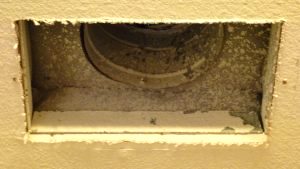 I used 15/32 inch plywood to make a 10" x 6" box duct box in the ceiling. It hangs
down 2'feet from the 9 foot ceiling. I used 15/32 inch plywood to make a 10" x 6" box duct box in the ceiling. It hangs
down 2'feet from the 9 foot ceiling. To minimize leaks, it's
deliberately a very tight fit, but it's also attached to the ceiling
with expansion bolts just to be sure it doesn't fall out.
(If you decide to build a plenum, remember the old rule: measure twice, cut once. Or in my case, measure 3 or 4 times.) After I built the plenum, I cut a 10" x 6" hole in the front
to mount a grille, and cut a 4" hole in the side for the 4" to 6" round adapter that connects it to the Quietflex. ALL HOOKED UP 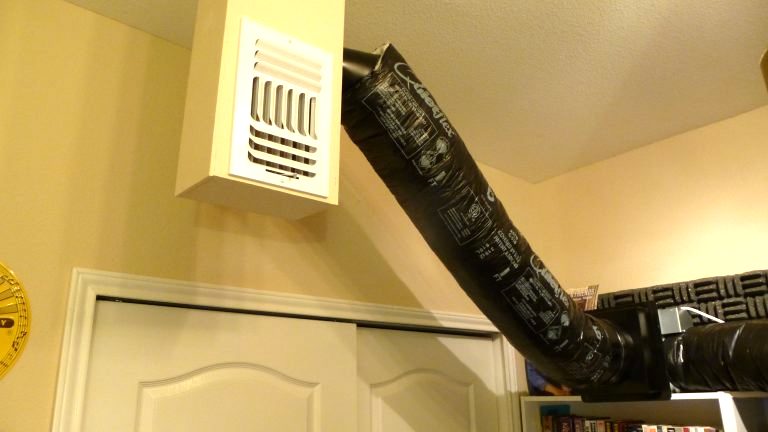 Here's how the system looks all hooked up. Here's how the system looks all hooked up.
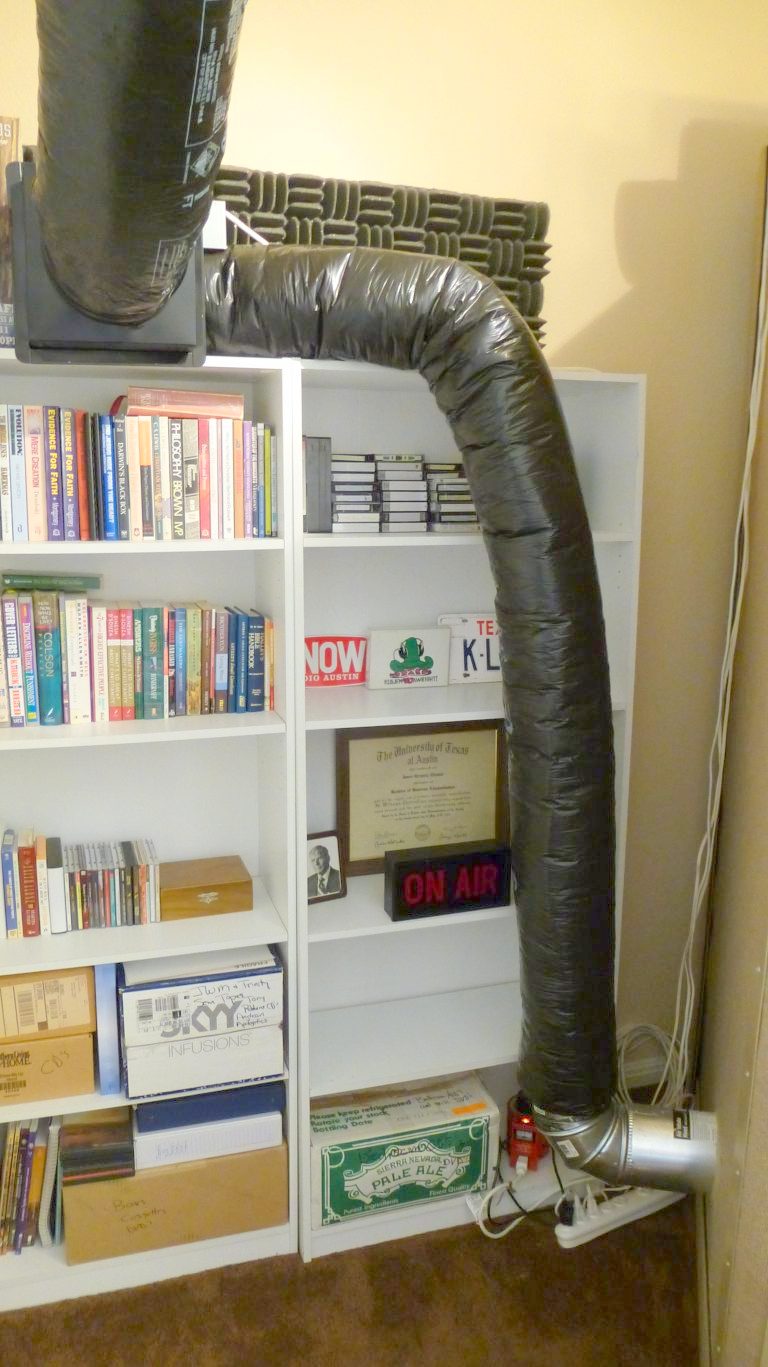 SO, HOW WELL DOES IT WORK? SO, HOW WELL DOES IT WORK? Beyond my wildest expectations !!! We try to keep our thermostat at 77°F in the summer, and at 80°F when
we're not at home. So before I built the plenum, the temperature inside
the booth was typically about 82°F.
But that was before I got in there and started voicing scripts.
After I'd been in the booth for 15 or 20 minutes, I was sweating away
because the temperature was up to 88°F. That's a 6 degree rise in only
20 minutes.
Just from my own body heat. Now, with everything connected, I can step into a pleasantly cool
76°F booth, and the temperature does not rise during a session. Instead
of working in an 88°F booth, I now work in a 76°F booth. That 12 degree difference is HUGE.
And if I set the house thermostat on 75°F, I can get the booth down to 70°F. FAN IS QUIET ENOUGH I thought I might have to close off the white grille in the front in
order to force enough air into the booth to keep it cool, but I don't.
The Panasonic fan pulls enough cold air into the booth without closing
the grille, so both the room and the booth stay cool. And since I'm using the same fan to ventilate the booth that I did
before, the noise floor hasn't changed. My VU meter still bounces around
between -54db to -57db when normalized to -3db. Not Hollywood recording
studio quiet, but quiet enough to keep my clients happy. And yes, I know: for a lower noise floor, I really should build a
proper baffle box instead of connecting the duct work directly to the
booth. But I don't have issues with noises getting in through the duct.
(Not even the psycho barking dog across the back fence.) So I'm not sure
how much improvement I would see in the noise floor by building one. But all of this was designed as a test of concept anyway. If it
didn't work, I wouldn't be out an arm and a leg, and if it did work, I'd
be cool.
And for a guy who never was one of the cool kids growing up, being cool is a big deal. THE MATERIALS AND COST Here's a list of the materials I used and their costs at the time of construction. Most items cost more now:
That's a total of $109.98 + 8.25% sales tax = $119.05. I already owned a drill and a jigsaw. REDUCE, REUSE, RECYCLE Of course, one of the reasons I was able to chill out so cheaply was
that I already had the Quietflex duct, the Panasonic fan, and a Variac
left over from my previous attempt to cool off the booth. You may be
able to keep costs down and tie your current booth into an air
conditioning duct using something similar to the design I created. The
Panasonic fan I'm using has been discontinued and replaced with a three
speed model. I'm assuming it's a better unit, but can't guarantee that.
You'll still need a Variac transformer to slow it down, though. Here
are sources for the Panasonic fan, the Quietflex duct, and the Variac
transformer:
All prices are plus shipping. You will also need a 3-prong extension
cord to connect the fan to the wall socket. Cut the socket off of the
extension cord and hard wire the cord to the fan. Because there is too much wind noise with the Panasonic fan running
at full speed, I slow the fan down to half speed with a Variac
transformer. If you decide to slow your fan down, do not use a standard
light dimmer to slow it down. A light dimmer won't keep the electricity
at 60 Hz, and it will eventually burn out the fan motor. A Variac
prevents this. *VocalBooth® is a registered trademark of VocalBooth.com, Inc. -------------------- ABOUT GREG Greg
Thomas, aka the Deep, Warm Voice, lives in San Antonio, TX with his
wife and an extraordinary standard poodle. Greg is a recovering
broadcaster who has been voicing scripts to inform, sell, and persuade
audiences in the U.S., Canada, Europe, China, and the Middle East for over
25 years. He has been recording VO from his professional home studio
for more than 10 years. In
his life before freelance voice over, Greg owned and managed a 100,000
watt radio station that he built from the ground up when he was 32. He
won 13 local Addy awards while he managed the station. His
VO clients include Verizon, Brawny Paper Towels, University of Notre
Dame, Irwin Vice Grip, Wounded Warrior Project, New York Red Bulls
Soccer, CSX Transportation, DuPont Pioneer, and Brugal Rum. When he's
not behind the mic or editing, he drives his wife, kids, and grandkids
crazy with his Dad jokes. Email: greg@DeepWarmVoice.com |
Tell Us What YOU Think!
Please Note: Since we check for spam, there will be a slight delay in the actual posting of your comment.
Comments
No comments have been posted yet. Hurry, and you could be the first!







.png)


click for new article alerts